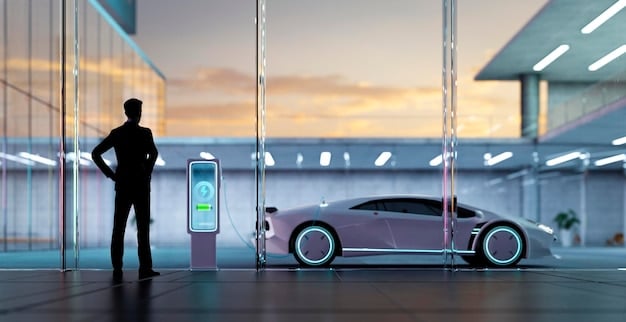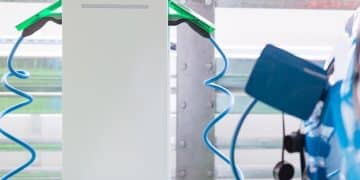The Future of Car Batteries: Solid-State vs. Lithium-Ion by 2030

The Future of Car Batteries: Will Solid-State Batteries Replace Lithium-Ion by 2030? Solid-state batteries are emerging as a potential successor to lithium-ion batteries in electric vehicles, promising increased energy density, enhanced safety, and faster charging times; however, challenges related to cost, scalability, and technological maturity remain before widespread adoption can occur.
The automotive industry is on the cusp of a significant transformation, largely driven by advancements in battery technology. One of the most anticipated developments is the potential shift from lithium-ion to solid-state batteries. Will The Future of Car Batteries: Will Solid-State Batteries Replace Lithium-Ion by 2030?
Understanding the Current Lithium-Ion Battery Landscape
Lithium-ion batteries have become the industry standard for electric vehicles (EVs), powering everything from compact cars to high-performance models. Their widespread adoption is due to their relatively high energy density and acceptable lifespan.
Advantages of Lithium-Ion Batteries
Lithium-ion batteries offer several key advantages that have made them the preferred choice for EVs currently on the market.
- High Energy Density: Lithium-ion batteries provide a greater energy density compared to older technologies like nickel-metal hydride, allowing EVs to travel farther on a single charge.
- Relatively Long Lifespan: With proper management, lithium-ion batteries can last for several years, often exceeding 100,000 miles in EV applications.
- Established Manufacturing Infrastructure: Decades of development have led to mature manufacturing processes, making lithium-ion batteries more affordable and readily available.
Limitations and Challenges
Despite their proven track record, lithium-ion batteries also have limitations that are driving the search for alternative technologies.
- Safety Concerns: Lithium-ion batteries use a flammable liquid electrolyte, which can pose a fire risk in the event of a short circuit or thermal runaway.
- Limited Energy Density: While superior to older technologies, lithium-ion batteries are approaching their theoretical energy density limits, hindering further range improvements.
- Charging Times: Compared to gasoline refueling, charging an EV with lithium-ion batteries can take significantly longer, especially with standard charging equipment.

These limitations have spurred intense research and development efforts aimed at creating safer, more energy-dense, and faster-charging battery solutions. Solid-state batteries are emerging as a promising contender to address these challenges, with the potential to revolutionize the EV landscape by 2030.
The Promise of Solid-State Batteries
Solid-state batteries represent a significant leap forward in battery technology, replacing the flammable liquid electrolyte with a solid electrolyte. This fundamental change unlocks several key advantages.
Enhanced Safety
One of the most compelling benefits of solid-state batteries is their improved safety profile. The solid electrolyte is non-flammable, significantly reducing the risk of fires and thermal runaway compared to lithium-ion batteries.
Increased Energy Density
Solid-state batteries have the potential to store more energy than their lithium-ion counterparts. This higher energy density translates to longer driving ranges for EVs without increasing battery size or weight. Some estimates suggest a potential increase in energy density of 50-100%.
Faster Charging Times
The use of a solid electrolyte can also enable faster charging times. Solid-state batteries are expected to be able to handle higher charging currents without the risk of degradation or safety issues. This could potentially reduce charging times to just a few minutes, on par with gasoline refueling.
These advantages make solid-state batteries a highly attractive alternative to lithium-ion technology. However, significant challenges remain before they can be mass-produced and widely adopted in EVs.

Challenges and Obstacles to Solid-State Battery Adoption
Despite the immense promise of solid-state batteries, several technical and economic hurdles must be overcome before they can replace lithium-ion batteries in EVs by 2030.
Manufacturing Scalability
Scaling up the production of solid-state batteries is a major challenge. Current manufacturing processes are complex and expensive, making it difficult to produce solid-state batteries on a large scale. New manufacturing techniques and equipment will be needed to achieve mass production.
Cost Competitiveness
The cost of solid-state batteries is currently much higher than that of lithium-ion batteries. Reducing production costs is crucial for making solid-state batteries economically viable for widespread use in EVs. Research and development efforts are focused on finding cheaper materials and streamlining manufacturing processes.
Technological Maturity
Solid-state battery technology is still in its early stages of development compared to lithium-ion technology. Issues such as electrolyte cracking, interface resistance, and overall battery lifespan need to be addressed to ensure reliable performance in EV applications.
Overcoming these challenges will require significant investments in research and development, as well as collaboration between battery manufacturers, automakers, and research institutions.
Key Players in the Solid-State Battery Race
Several companies are actively involved in the development of solid-state batteries, each with their own unique approaches and timelines.
Automakers
Many major automakers are investing heavily in solid-state battery technology.
- Toyota: Toyota is one of the leading companies in solid-state battery development. They aim to release an EV with solid-state batteries in the early 2020s.
- Volkswagen: Volkswagen is partnering with QuantumScape, a solid-state battery startup, to develop and commercialize solid-state batteries for their EVs.
- Ford: Ford is also investing in solid-state battery technology through its partnership with Solid Power, another promising startup.
Battery Manufacturers
Traditional battery manufacturers are also making strides in solid-state battery development.
- Samsung SDI: Samsung SDI is developing solid-state batteries with both sulfide-based and oxide-based electrolytes.
- LG Energy Solution: LG Energy Solution is also exploring solid-state battery technology to enhance the performance and safety of their EV batteries.
Startups
Numerous startups are focused on developing and commercializing solid-state batteries.
- QuantumScape: QuantumScape is one of the most well-funded and closely watched solid-state battery startups. They have made significant progress in improving the energy density and cycle life of their solid-state batteries.
- Solid Power: Solid Power is developing sulfide-based solid-state batteries and has partnerships with several major automakers.
The competitive landscape is rapidly evolving, with new players and partnerships emerging regularly.
Projecting the Future: Solid-State Batteries by 2030
Predicting the future of battery technology is a complex task, but several factors suggest that solid-state batteries could play a significant role in the EV market by 2030.
Potential Market Penetration
While it is unlikely that solid-state batteries will completely replace lithium-ion batteries by 2030, they could capture a significant share of the EV market, particularly in high-end models where performance and safety are paramount. Some analysts predict that solid-state batteries could power up to 20% of new EVs by the end of the decade.
Continued Technological Advancements
Ongoing research and development efforts are expected to yield further improvements in solid-state battery technology. These advancements could address the current limitations and pave the way for wider adoption. Key areas of focus include increasing energy density, reducing production costs, and improving battery lifespan.
Impact on the EV Industry
The widespread adoption of solid-state batteries could have a transformative impact on the EV industry. Longer driving ranges, faster charging times, and enhanced safety would make EVs more appealing to a wider range of consumers. This could accelerate the transition to electric vehicles and help reduce greenhouse gas emissions from the transportation sector.
Ultimately, the success of solid-state batteries will depend on overcoming the remaining technical and economic challenges. However, the potential benefits are so significant that continued investment and development are virtually guaranteed.
The Environmental and Economic Implications
The shift to solid-state batteries has significant environmental and economic implications that extend beyond the automotive industry.
Environmental Benefits
Solid-state batteries offer several potential environmental advantages over lithium-ion batteries. The elimination of the flammable liquid electrolyte reduces the risk of fires and chemical spills, making them a safer and more environmentally friendly option. Additionally, the potential for higher energy density could reduce the overall size and weight of EV batteries, leading to greater energy efficiency.
Economic Opportunities
The development and production of solid-state batteries could create new economic opportunities and jobs in the battery manufacturing, materials science, and automotive sectors. Governments and industries are investing heavily in solid-state battery research and development, recognizing the potential for economic growth and technological leadership. The United States, for example, has announced several initiatives to support domestic battery production and reduce reliance on foreign suppliers.
Resource Considerations
The materials used in solid-state batteries may differ from those used in lithium-ion batteries, potentially shifting the demand for certain raw materials. Careful consideration of resource availability and sustainable sourcing practices will be essential to ensure that the transition to solid-state batteries does not create new environmental or social challenges.
| Key Point | Brief Description |
|---|---|
| ⚡ Safety | Solid-state batteries offer enhanced safety due to non-flammable electrolyte. |
| 🔋 Energy Density | Potential for higher energy density enables longer driving ranges. |
| ⏱️ Charging | Faster charging times may be achieved with solid-state technology. |
| 💰 Cost | Reducing production costs is a major challenge for widespread adoption. |
FAQ
▼
Solid-state batteries replace the liquid electrolyte found in lithium-ion batteries with a solid electrolyte. This results in increased safety, potentially higher energy density, and faster charging times. They are viewed as a next-generation battery technology for electric vehicles.
▼
Solid-state batteries enhance safety by using a non-flammable solid electrolyte, which eliminates the risk of fire and thermal runaway associated with the flammable liquid electrolytes found in lithium-ion batteries. This makes them a safer option for electric vehicles.
▼
The main challenges include manufacturing scalability, high production costs, and technological maturity. These hurdles need to be overcome to make solid-state batteries economically viable and widely adopted in electric vehicles. Further research and development are crucial.
▼
Key players include automakers like Toyota, Volkswagen, and Ford, as well as battery manufacturers like Samsung SDI and LG Energy Solution. Startups such as QuantumScape and Solid Power are also significant contributors to solid-state battery technology development.
▼
While complete replacement of lithium-ion batteries is unlikely by 2030, solid-state batteries could capture a significant share of the EV market, potentially powering up to 20% of new EVs. Continued technological advancements are expected to accelerate adoption.
Conclusion
The future of car batteries is undoubtedly linked to innovations that promise enhanced safety, greater energy density, and faster charging capabilities. While lithium-ion batteries currently dominate the electric vehicle market, the emergence of solid-state batteries presents a compelling alternative. Whether solid-state batteries will fully replace lithium-ion technology by 2030 remains to be seen, but their potential impact on the automotive industry and beyond is undeniable, marking a significant step toward a more sustainable and efficient transportation future.





